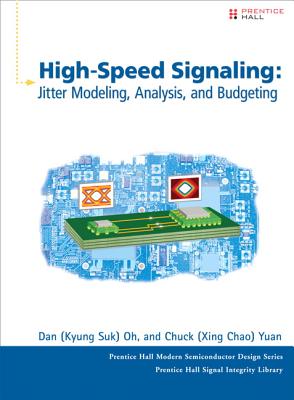You are here
Back to topHigh-Speed Signaling: Jitter Modeling, Analysis, and Budgeting (Prentice Hall Modern Semiconductor Design) (Hardcover)
This title is not available for purchase
Out of Print
Description
New System-Level Techniques for Optimizing Signal/Power Integrity in High-Speed Interfaces--from Pioneering Innovators at Rambus, Stanford, Berkeley, and MIT
As data communication rates accelerate well into the multi-gigahertz range, ensuring signal integrity both on- and off-chip has become crucial. Signal integrity can no longer be addressed solely through improvements in package or board-level design: Diverse engineering teams must work together closely from the earliest design stages to identify the best system-level solutions. In High-Speed Signaling, several of the field's most respected practitioners and researchers introduce cutting-edge modeling, simulation, and optimization techniques for meeting this challenge. Edited by pioneering experts Drs. Dan Oh and Chuck Yuan, these contributors explain why noise and jitter are no longer separable, demonstrate how to model their increasingly complex interactions, and thoroughly introduce a new simulation methodology for predicting link-level performance with unprecedented accuracy. The authors address signal integrity from architecture through high-volume production, thoroughly discussing design, implementation, and verification. Coverage includes
- New advances in passive-channel modeling, power-supply noise and jitter modeling, and system margin prediction
- Methodologies for balancing system voltage and timing budgets to improve system robustness in high-volume manufacturing
- Practical, stable formulae for converting key network parameters
- Improved solutions for difficult problems in the broadband modeling of interconnects
- Equalization techniques for optimizing channel performance
- Important new insights into the relationships between jitter and clocking topologies
- New on-chip measurement techniques for in-situ link performance testing
- Trends and future directions in signal integrity engineering
About the Author
Kyung Suk (Dan) Oh received the B.S., M.S., and Ph.D. degrees in electrical engineering from the University of Illinois, Urbana-Champaign, in 1990, 1992, and 1995, respectively. His doctoral research was in the area of computational electromagnetics applied to transmission line modeling and simulation. He is a Senior Principal Engineer at Rambus Inc. He leads signal integrity analysis for various products including serial, parallel, and memory interfaces. He is also responsible for developing advanced signal and power integrity analysis tools. His current interests include advance signal and power integrity modeling and simulation techniques, optimization of channel designs for various standard or proprietary I/O links, and application of signaling techniques to high-speed digital links. Dr. Oh has published more than 80 papers and holds 7 issued U.S. patents and 10 pending patent applications in areas of high-speed link design. He received two Best Paper Awards in DesignCon and 2008 Best Paper Award in the IEEE Advanced Packaging journal. Dr. Oh serves on the technical program committee of IEEE EPEPS, and is a former member of the IEC DesignCon Technical Program Committee. Xingchao (Chuck) Yuan received his B.S. degree in Electronic Engineering from Nanjing Institute of Technology (now Southeast University), Nanjing, China, in 1982. He received both his M.S. and Ph.D. degrees in Electrical Engineering from Syracuse University, Syracuse, New York, in 1983 and 1987, respectively. After receiving his Ph.D., Dr. Yuan was at the Thayer School of Engineering at Dartmouth College; first as a Postdoctoral fellow, and later as a Research Assistant Professor from 1987 to 1990. From 1990 to 1995, Dr. Yuan was employed by Ansoft Corp., where he led the development of Ansoft's flagship product HFSSTM (High Frequency Structure Simulator). His work led to three different product releases, which included features such as modeling conductor and dielectric loss, radiation and periodic boundary conditions for modeling antennas, and electromagnetic scattering/interference problems. He pioneered a fast frequency sweep method that combined a finite element method and an asymptotic waveform evaluation method. This led to a dramatic speed improvement in the speed of 3D full-wave modeling. From 1995 to 1998, Dr. Yuan was with Cadence Corp. where he led the research and development of the signal integrity and EMI tools. His work focused on modeling SSO noise and induced electromagnetic interference, which led to some of the earliest research in power plane modeling. Since 1998, Dr. Yuan has been with Rambus Inc, Sunnyvale, California, as a director of signal integrity engineering. Dr Yuan is responsible for designing, modeling, and implementing Rambus multi-gigahertz signaling technologies using conventional interconnect technologies. His technical and managerial leadership at Rambus has led to an industry-recognized signal and power integrity team of experts. Rambus' SI/PI papers are closely followed by the rest of the industry, and represent the latest developments in high-performance signal and power integrity modeling and design. Dr. Yuan's team was among the first to apply BER and statistical methodology to memory interface designs, and to explore the relationship between the supply noise spectrum and the jitter spectrum. His team's work led to the successful development of Rambus' XDR memory architecture, which was adopted by PlayStation 3, DLP projectors, and DTVs. Since 2009, Dr. Yuan has served as an engineering director in charge of a silicon team with dozens of engineers (in both the U.S. and India) who are responsible for designing next-generation Rambus graphics and main memory interfaces. In 2010, the team taped out a multi-modal PHY that explores the limits of single-ended signaling beyond 12.8Gbps, a power efficient differential interface at 20Gbps, and backward compatibility with existing memory interfaces (including GDDR5 and DDR3). Dr. Yuan has authored more than 100 papers in technical journals and conferences and holds 8 issued U.S. patents. He is a senior member of IEEE, and served on the technical program committee of IEEE EPEPS from 2008 to 2009.
